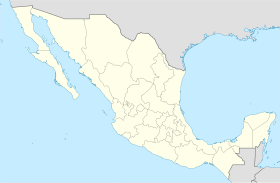Punta Colonet
| Punta Colonet Chuwílo Ksaay | |
|---|---|
| Location in Mexico | |
| Coordinates: 31°04?24?N 116°12?28?W Coordinates : 31°04?24?N 116°12?28?W | |
| Country | |
| State | Baja California |
| Municipality | Ensenada |
| Elevation | 157 ft (48 m) |
| Population (2010) | |
| • City | 3,278 |
| • Urban | 3,278 |
| Time zone | Northwest US Pacific ( UTC-8 ) |
| • Summer ( DST ) | Northwest ( UTC-7 ) |
Punta Colonet (Chuwílo Ksaay ( dry arroyo ) in the Kiliwa language ), north of San Quintín, Baja California , is one of the most productive agricultural areas in Mexico 's Baja California peninsula . Its proximity to Mexican Federal Highway 1 and the United States have spurred the growth of large commercial farming in the area. Punta Colonet is a beautiful, unspoiled area where orchards and farms run right to the ocean's edge. The point, nearby town, bay, and cape are reputedly named after Captain James Colnett , a British sea captain who explored this section of the Pacific coast in the late 18th century. There has been tremendous growth in the region over the last five years.
| |
History
During Prohibition , the Canadian rum-runner Malahat allegedly anchored off Cape Colnett as a mother ship, providing liquor which was smuggled north to San Diego . [ 1 ]
Proposed Port
There is a proposal to turn the bay ( Bahía Colonet ) near Punta Colonet, a desolate and sparsely inhabited inlet, into a multi-billion dollar deep water mega-container port able to handle next-generation vessels. [ 2 ] [ 3 ] The mega-port will cover 30 km² which more than 70 km², making it as large as the U.S. ports of Los Angeles and Long Beach combined. The projected multimodal maritime center would make Punta Colonet the largest port in Mexico and the third-largest in the world, after Singapore and Hong Kong. [ 4 ] Port operations will require a city of up to 200,000 people. [ 5 ] The project will require a new power plant and a desalination plant. The port will also require a 300 km plus (200 miles) rail line from the Port to reach the United States border and an intermodal facility.
On August 17, 2009, Mexico Transportation and Communications Minister Juan Molinar Horcasitas announced the project will move ahead, and that a new timetable would soon be issued. On October 8, 2009, Mexico’s Secretary of Communications and Transport Juan Francisco Molinar Horcasitas said the project would start with a reduced near-term plan to handle one million containers (TEUs) per year, a figure “viable in light of declining Pacific ship traffic.” This is down from the original target of 2 million/year. He also said that bids will be accepted in the range of $1–3 billion, and he reiterated that four groups of companies are expected to submit construction-and-operation bids.
On December 14, 2009, after two years of work and expenditure of $1 million, the Mexican government issued urban and port development plans for the coming mega-port at Punta Colonet. From today’s population of 9,000, Punta Colonet will grow to 48,000 within five years, and 230,000 by 2040, according to the planning document issued by the Urban Development Program of the Center for Population and the City Planning Institute of Ensenada.
Rationale
If the port is not built, containers may have to be shipped in the port at Lázaro Cárdenas, Michoacán where expansion is currently underway to increase volumes, due to congestion at the ports of Los Angeles , Long Beach , and Oakland , which is even farther, unless expansion plans in US ports are aggressive enough.
Lázaro Cárdenas is used now on a small scale as a shipping gateway to interior US cities such as such as Chicago , Kansas City , and Houston (Houston, TX, is not an inland city; it is a port city connected to the Gulf of Mexico), as it is closer to the heart of the continent than Los Angeles. Puerto Colonet on the other hand would be closer to fast growing Arizona , Nevada and other mountain states and could serve as a bypass to the congested Los Angeles region with a comparable distance to those markets, and it would be over a thousand kilometers closer than the port at Lázaro. Currently, ships often have to wait a week to unload in the Los Angeles region, and large truck congestion is a big problem on the Interstate 710 and other connecting highways in the LA Basin. The current situation also causes a problem even for Los Angeles businesses as their cargos on ships are unloaded by time of arrival not proximity of destination.
The port of Guaymas which has an already existing rail and four lane highway connection to the interior and United States is also seeking to increase its traffic in containers and bulk cargo but further development of Guaymas will not preclude expansion at Lazaro Cardenas or Punta Colonet.
Thus, ports and jobs could be kept in the US, but at a much higher overall cost, as much of California's infrastructure is already maxed out.
The mega-port also would be expected to be a boon to the Baja California regional economy, providing several hundred thousand jobs directly or indirectly. A city nearby will need to be built, and highways and railways upgraded, providing vast economic growth potential.



